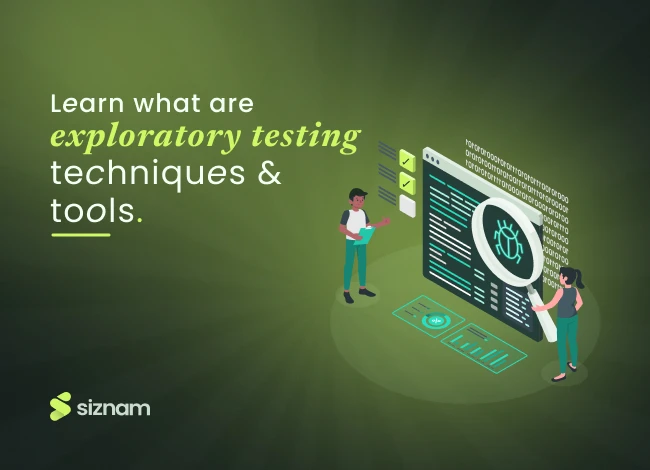Introduction
Testing is performed to make your product reliable and error-free. Whenever testing is performed, it is done with a proper set of instructions and some predefined test cases to make the process fast and simple. These tests provide better results, but the testing isn’t always user-centric. But there’s another form of testing where no test cases are involved and the testers move with their intuitions. Such testing is called exploratory testing techniques. But what is exploratory testing? What are its involved types and benefits? And what kinds of exploratory testing tools are used in it? This blog will cover all of these aspects.
What is Exploratory Testing?
So first thing first, let’s learn about exploratory testing. This is a type of testing in which the testers test a product without following the already defined test cases and plans. In exploratory testing techniques, the testers just take the product and start testing its features just like a user uses it by checking its different functions and features randomly. This testing helps you to check the product from the user’s point of view enabling your product to deliver a better user experience to your users.
Some Types of Exploratory Testing
Exploratory testing techniques have several types in each type of testing deals with a different feature of the product and provides you with extraordinary results. Following are some types of exploratory testing methods
Ad-hoc Testing:
Imagine diving into an app without any formal plan, just following your instincts. That’s ad-hoc testing! You explore freely, clicking around and experimenting to see what breaks. It’s like a spontaneous adventure, relying on your gut feeling and experience to uncover those sneaky bugs.
Pair Testing:
A very important type of exploratory testing method is pair testing. Two heads are better than one, right? In pair testing, you team up with a buddy. One of you handles the keyboard while the other observes and suggests new ideas. This tag-team approach not only makes testing more fun but also helps you catch issues that you might miss when working solo.
Bug Hunts:
Picture a group of testers on a mission, racing against the clock to find as many bugs as possible. That’s a bug hunt! It’s a high-energy, collaborative effort where everyone brings their unique perspective to the table. The friendly competition and shared goal make it an exciting way to uncover hidden defects.
Benefits of Exploratory Testing
Exploratory testing benefits are numerous. This testing is designed to give you results that not only remove bugs from the products but also help you in delivering a better user experience. Following are some exploratory testing benefits:
Uncovering Unexpected Bugs:
Exploratory testing lets you find those sneaky bugs that might have been missed in other forms of testing.. By experimenting freely, you can find those hidden bugs that you couldn’t find with other scripted tests. It’s like being a detective, discovering clues and solving mysteries within the application.
Enhanced Tester Creativity:
This testing style gives you the freedom to think outside the box. Without the constraints of predefined test cases, you can explore different angles and scenarios. It’s a great way to tap into your creativity and intuition, making the testing process more enjoyable and effective.
Quick Adaptation to Changes:
In fast-paced development environments, things change rapidly. Exploratory testing allows you to adapt quickly to these changes. Instead of waiting for updated test cases, you can immediately dive in and start testing new features or fixes, ensuring continuous quality even in agile settings.
Better Understanding of the Application:
When you explore an app freely, you get to know it inside out. This hands-on approach helps you understand the application’s functionality and user flows deeply. As you interact with different parts of the app, you build a mental map, making you a more knowledgeable and effective tester.
Improved Collaboration
Exploratory testing often involves collaboration, whether through pair testing or bug hunts. Working closely with others fosters better communication and idea-sharing. It creates a better environment where you can learn from each other’s insights and make your testing process efficient.
Reliable Exploratory Testing Tools
There are several tools available in the market for exploratory testing, but not all of them are capable enough to provide you with the results you expect. Following are some very famous exploratory testing tools that provide you with better results than you expected:
TestRail:
Testrail is a very important exploratory testing software or tool. This tool makes it easy to organize your exploratory testing. You can capture notes, take screenshots, and track your progress, all while keeping your team in the loop for better collaboration.
Session-Based Test Management (SBTM):
Tools like Rapid Reporter help you stay organized during exploratory testing sessions. They let you document your charters and findings in real time, making sure nothing important slips through the cracks.
Qase:
The next exploratory testing software is Qase which is great for logging your exploratory testing activities. You can jot down insights and report bugs on the fly, helping you keep everything neat and accessible for later review.
Xray:
Xray integrates smoothly with Jira, letting you document your exploratory test sessions right within your project workflow. It’s perfect for keeping everything in one place and easy to manage.
Exploratory Testing Chrome Extension:
This handy browser extension lets you take notes, snap screenshots, and report bugs directly while exploring web apps. It’s a straightforward way to document your findings without interrupting your flow.
Exploratory Testing Techniques
Exploratory testing is a very reliable form of testing that provides you with the best results if performed properly. However, the testing can be made more efficient if the given exploratory testing techniques are followed properly:
Note-taking and Documentation:
A very important exploratory testing approach is documentation. Think of your testing session as an adventure diary. Jot down everything you encounter interesting sights, unexpected twists, and hidden treasures. These notes not only keep you organized but also serve as valuable records of your exploration.
Exploratory Testing Tours:
Just like exploring a new city, break down your testing into themed tours. Whether it’s a stroll through functionality street or a hike up usability hill, these tours help you cover different areas systematically, ensuring nothing gets overlooked.
Mind Mapping:
One of the best exploratory testing approaches is mind mapping. Picture your testing ideas as branches of a tree, growing and intertwining. Mind maps help you visualize this growth, connecting thoughts and uncovering new paths. They’re like your personal exploration roadmap, guiding you through uncharted territory.
Adaptive Testing Strategy:
Flexibility is key in exploratory testing—it’s like navigating changing weather on a hike. Be prepared to adjust your route as you go, responding to new information and unexpected obstacles to ensure you reach your destination. Having adaptive testing strategies always makes your exploratory testing process more efficient.
Exploratory Testing Sessions:
Think of each testing session as a mini-adventure, complete with its quest and challenges. Set a timer, dive in, and immerse yourself in the exploration. Afterward, take a breather, review your discoveries, and prepare for the next adventure.
Feedback Loop and Collaboration:
Exploration is more fun with friends, right? Share your findings with others, swap stories, and learn from each other’s experiences. It’s like comparing notes after a group hike—everyone gains new insights and discoveries.
Assess Risk Properly
Every journey has its risks, but with careful planning, you can navigate them safely. Identify potential hazards in your exploration and always try to prioritize them. Also beside this, take steps to mitigate any threats and ensure a smoother journey ahead.
Focus on Continuous Learning
Exploration is about discovery, and there’s always something new to learn. Try out different techniques and embrace the thrill of the unknown. After all, every discovery is a step forward in your exploration journey.
Conclusion
The exploratory testing process not only helps you test your software, application, and website for bugs and errors but also helps you to make sure you are doing it from the perspective of the user. This testing gives you a better functioning project to help you deliver a better user experience. This testing provides you with better adaptation to benefits, improved communication, and collaboration. And there are several more benefits of exploratory testing. So always make sure you hire a reliable exploratory testing company like Siznam that provides you with testing results that exceed your expectations.






